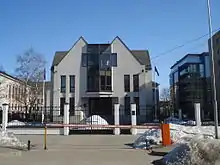Latvia–Lithuania relations
Latvian–Lithuanian relations are bilateral international relations between Latvia and Lithuania. Latvia has an embassy in Vilnius, and Lithuania has an embassy in Riga.
 | |
Latvia |
Lithuania |
|---|---|
| Diplomatic mission | |
| Latvian Embassy, Vilnius | Lithuanian Embassy, Riga |
| Envoy | |
| Ambassador Einars Semanis | Ambassador Antanas Vinkus |

Both states share a long common history: both Latvians and Lithuanians belong to the family of Baltic peoples, speakers of the Baltic languages. The territory of Latvia and Lithuania were together part of the Grand Duchy of Lithuania and the Polish–Lithuanian Commonwealth between 1561 and 1772 (with a brief period of Swedish rule in what is now Latvia in between). Between the late 18th century and 1918, the territory of both Lithuania and Latvia was part of the Russian Empire. Lithuania and Latvia re-established their diplomatic relations on October 5, 1991, after independence from the Soviet Union.
The two states share 588 kilometres (365 mi) of common border. Both countries are full members of the European Union.
Country comparison
| Flag |  |
 |
| Coat of Arms |  |
 |
| Population | 1,953,200[1] | 2,810,865[2] |
| Area | 64,589 km2 (24,938 sq mi) | 65,300 km2 (25,200 sq mi) |
| Population density | 34.3/km2 (88.9/sq mi) | 43/km2 (111/sq mi) |
| Capital | Riga | Vilnius |
| Largest city | Riga - 641,423 (1,018,295 Metro) | Vilnius - 545,280 (805,173 Metro) |
| Government | Unitary parliamentary constitutional republic | Unitary semi-presidential republic[3] |
| First Leader | Jānis Čakste | Antanas Smetona |
| Current Leader | Egils Levits (President) Krišjānis Kariņš (Prime Minister) |
Gitanas Nausėda (President) Ingrida Šimonytė (Prime Minister) |
| Official languages | Latvian | Lithuanian |
| Main religions | 80% Christianity (34.3% Lutheranism, 25.1% Catholicism, 19.4% Eastern Orthodoxy/Old Believers, 1.2% other Christian), 20% non-Religious | 82.1% Christianity (77.2% Catholicism, 4.9% Eastern Orthodoxy/Old Believers), 10.1% undeclared, 6.1% non-Religious, 1.67% other [4] |
| Ethnic groups | 62% Latvian, 25.4% Russian, 3.3% Belarusian, 2.2% Ukrainian, 2.1% Polish, 1.2% Lithuanian, 3.8% other[5] | 86.7% Lithuanian, 5.6% Polish, 4.8% Russian, 1.3% Belarusian, 0.7% Ukrainian, 0.9% other |
| GDP (nominal) | $30.176 billion ($15,403 per capita) | $51.372 billion ($18,312 per capita) |
| GDP (PPP) | $53.467 billion ($27,291 per capita) | $95.591 billion ($34,074 per capita) |
| Real GDP growth rate | 2.00% | 2.30% |
1920s border dispute
In the early 1920s, Latvia and Lithuania had a peaceful dispute about the towns of Palanga and Šventoji which were initially part of Latvia following the country's independence but were of strategic interest to Lithuania. The dispute was peacefully resolved in 1921 with the help of an international commission, and the territories were transferred to Lithuania. As a compensation, Latvia received the Latvian-majority territories of what now are Ukri Parish, Brunava Parish, Aknīste Parish. Latvia's claims on the town of Mažeikiai were rejected by the international commission. The Lithuanians had to drop their claims on Ilūkste Municipality and Daugavpils.[6]
Resident diplomatic missions

See also
References
- "The number of population is decreasing – the mark has dropped below 2 million". Central Statistical Bureau of Latvia. Nov 2015. Archived from the original on 2017-10-14. Retrieved 6 May 2014.
- "Statistikos departamentas".
- Kulikauskienė, Lina (2002). Lietuvos Respublikos Konstitucija [The Constitution of the Republic of Lithuania] (in Lithuanian). Native History, CD. ISBN 9986-9216-7-8.
- Department of Statistics to the Government of the Republic of Lithuania. "Ethnicity, mother tongue and religion". Archived from the original on 2014-10-08. Retrieved 2018-01-05.. 2013-03-15.
- Latvijas iegūtās un zaudētās teritorijas - neogeo.lv, November 10, 2011
External links
- (in Latvian, English, Lithuanian, and Russian) Embassy of the Republic of Latvia in the Republic of Lithuania
- (in English, Lithuanian, and Russian) Embassy of the Republic of Lithuania in the Republic of Latvia